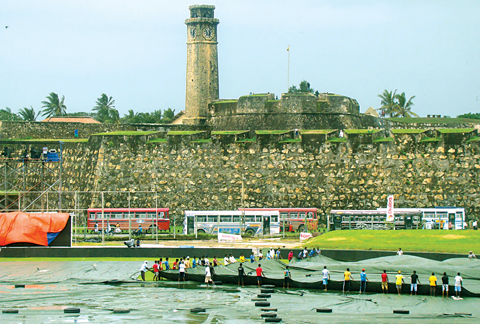Sri Lanka has fastest ground staff in the world
by Sharda Ugra
At one point after the 15th over on the first day of the third Test,
the grounds men on either side of the SSC square moved in.
There was no rain, but they knew.. In the media box with its views of
the city, the construction cranes, scattered multi-storey towers, the
white cupola of the town hall, and the slowly rising Lotus Tower were
being obliterated by a curtain of grey.
The grounds-keeping team was on standby five minutes before they made
their first move. By the time the rain came, in slanting silver, the men
had the pitch and the square covered. With the rain beating down
fiercely, they next covered the bowlers' run-ups. In under nine minutes
80% of the field was under the large covers. The groundsmen, divided
into four crews, dragging out waterproof sheets 100 feet square, were
perfectly synchronised in their movements, much like an F1 pit crew.
|

Ground staff at work at the Galle International stadium |
The cricket crew works over a much larger tract of land but their
operation also requires speed of a relatively different scale and a
sequential order of its own. This high-speed ground-covering is a
specialty of Sri Lankan cricket -brought about as a solution to having
to play most of their home international cricket in what is
traditionally the country's off season, when it rains - not in buckets
but intermittently, like it threatened to during the Galle Test and at
the P Sara, and like it eventually did after an hour on day one at the
SSC.
Sri Lanka play their home Tests in two batches - one lot in March and
then between June and September. For the last ten years or so, this
logistical exercise has taken place before every big match in Sri Lanka.
A few days before a game,close to 100 men are signed on as casual labour
to add to the official ground-staff strength of around 15. They are then
divided into four groups,each with a leader, usually an experienced
groundsman.
The groups undergo a simulated, timed exercise of pulling on the
covers. The following morning the covers are pulled off to the count of
a stopwatch. Every ground has around 10 to 15 giant rubberised canvas
sheets, imported from India, each costing about LKR 800,000 (nearly
US$6000). Since the 2011 World Cup, each ground in the country has its
own set.
Jayananda Warnaweera, the Southern Province cricket association
secretary, general boss, curator and caretaker of the Galle
International Stadium, says Sri Lankan grounds-keeping drills are
"unlike any other in the world".
Galle's grounds-keepers need the extra assistance of used truck tyres
to hold down the covers when strong winds come in from the sea next
door. When asked what the tyres weigh, Chamara and Sampath look at each
other.They are part of the casual labour for the first Test, earning LKR
1000 ($7.44) a day. One is a tuk-tuk driver and the other a mobile phone
repairman. With a straight face comes the reply, "Thirty kilos."
Whatever the weight, these are substantial tyres, well over car size.
Maybe 15-20kg minimum each then?
Before the 2011 World Cup new grounds were built in Pallekele and
Hambantota,with improved drainage and sprinkler systems. The country's
flagship ground,the R Premadasa Stadium in Khettarama, Colombo, was
raised by 3.5ft. At the ICC World T20 in 2012, ten minutes was set as
the benchmark for bringing in the covers. (Sharda Ugra is senior editor
at ESPNcricinfo) |

